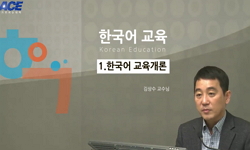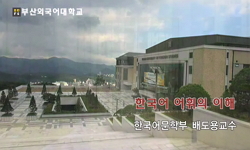Most studies on borrowed words in Korean lexis studies are approaching about concept and formation of borrowed words, transcription rules and their problems, and how to refine Korean. However, differently with this, studies on borrowed words for forei...
http://chineseinput.net/에서 pinyin(병음)방식으로 중국어를 변환할 수 있습니다.
변환된 중국어를 복사하여 사용하시면 됩니다.
- 中文 을 입력하시려면 zhongwen을 입력하시고 space를누르시면됩니다.
- 北京 을 입력하시려면 beijing을 입력하시고 space를 누르시면 됩니다.

외국인을 위한 한국어 외래어 교육 목록 선정에 관한 연구 = A Study on Selection of Educational Korean Borrowed Words for Foreigner
한글로보기부가정보
다국어 초록 (Multilingual Abstract)
Therefore, this study tries to define the concept of borrowed words and determine the range that should be dealt in Korean education as a foreign language for effective teaching Korean to foreign learners. Also this study compared frequency of borrowed words in Korean textbooks with items in Cho Namho(2003). Lastly this study analyzed how much foreign learners, foreign students staying in Korea quite a long time and foreign learners in advanced level, recognize borrowed words.
Most studies on borrowed words in Korean lexis studies are approaching about concept and formation of borrowed words, transcription rules and their problems, and how to refine Korean. However, differently with this, studies on borrowed words for foreigners should be dealt as courses of acquiring basic vocabulary, because most foreigners studying Korean point out that borrowed words are main obstacles to acquiring and studying Korean vocabulary when communicating. Korean learners naturally acquire borrowed words in the same way that they acquire Korean, while foreign learners feel double difficulties in acquiring borrowed words. Therefore, different teaching contents and methods are to be prepared according to the object of teaching. When teaching borrowed words to Koreans, main point is that learners should know exactly the origin of borrowed words and use them properly because excessive using them may taint Korean. On the other hand, teaching it to foreigners focuses on an efficiency of communication and makes foreign learners understand formation and meaning of borrowed words in Korean.
Therefore, this study tries to define the concept of borrowed words and determine the range that should be dealt in Korean education as a foreign language for effective teaching Korean to foreign learners. Also this study compared frequency of borrowed words in Korean textbooks with items in Cho Namho(2003). Lastly this study analyzed how much foreign learners, foreign students staying in Korea quite a long time and foreign learners in advanced level, recognize borrowed words.
참고문헌 (Reference)
1 문승실, "한국어학습자를 위한 외래어 교육 방안 연구" 2004
2 강승혜, "한국어교육의 학문적 정체성 정립을 위한 한국어교육 연구 동향분석" 14 (14): 18-, 2003
3 이상숙, "한국어 학습자의 외래어 표기 오류 분석 및 교수 방안 연구" 2005
4 이정희, "한국어 학습자의 오류 연구" 박이정 71-72, 2003
5 이정희, "한국어 학습자의 어휘 오류 분류에 관한 연구" 이중언어학회 (29) : 321-346, 2005
6 조남호, "한국어 학습용 어휘 선정 결과 보고서" 국립국어연구원 16-34, 2003
7 김하수, "한국어 외래어 표기법의 문제점" 배달말학회 2집 : 247-259, 1999
8 조은호, "한국어 외래어 교육 연구" 경희대학교 교육대학원 73-77, 2006
9 조현용, "한국어 어휘 교육 연구" 박이정 2000
10 이병규, "한국어 교재 분석 연구" 국립국어원 229-273, 2005
1 문승실, "한국어학습자를 위한 외래어 교육 방안 연구" 2004
2 강승혜, "한국어교육의 학문적 정체성 정립을 위한 한국어교육 연구 동향분석" 14 (14): 18-, 2003
3 이상숙, "한국어 학습자의 외래어 표기 오류 분석 및 교수 방안 연구" 2005
4 이정희, "한국어 학습자의 오류 연구" 박이정 71-72, 2003
5 이정희, "한국어 학습자의 어휘 오류 분류에 관한 연구" 이중언어학회 (29) : 321-346, 2005
6 조남호, "한국어 학습용 어휘 선정 결과 보고서" 국립국어연구원 16-34, 2003
7 김하수, "한국어 외래어 표기법의 문제점" 배달말학회 2집 : 247-259, 1999
8 조은호, "한국어 외래어 교육 연구" 경희대학교 교육대학원 73-77, 2006
9 조현용, "한국어 어휘 교육 연구" 박이정 2000
10 이병규, "한국어 교재 분석 연구" 국립국어원 229-273, 2005
11 민현식, "한국 외래어에 대한 연구" 한국어의미학회 (2) : 91-132, 1998
12 정호성, "표준국어대사전 수록 정보의 통계적 분석" 국립국어연구원 10 (10): 56-72, 2000
13 장성희, "중국인 학습자를 위한 한국어 외래어 교육 방안" 2007
14 박경자, "응용언어학사전" 경진문화사 58-, 2001
15 김수현, "외래어표기법연구" 2003
16 유재원, "외래어의 올바른 수용 태도" 국립국어연구원 14 (14): 103-116, 2003
17 정희원, "외래어의 개념과 범위" 국립국어연구원 14 (14): 5-22, 2004
18 임홍빈, "외래어의 개념과 그 표기법의 형성과 원리" 태학사 199-, 1997
19 강신항, "외래어가 국어에 끼친 공과" 국립국어연구원 14 (14): 23-58, 2004
20 박창원, "외래어 표기 양상의 변천" 국립국어연구원 14 (14): 59-102, 2004
21 민현식, "국어 정서법 연구" 태학사 349-393, 2001
22 金重燮, "外國人을 위한 韓國語 漢字敎育 硏究" 韓國語文敎育硏究會 25 (25): 95-113, 1997
23 金智衡, "外國人 한국어 학습자를 위한 교육용 基本漢字의 選定" 韓國語文敎育硏究會 31 (31): 377-402, 2003
24 김문창, "“의사외래어의 문제점”" 636-6487, 1989
25 박갑천, "“외래어 사용의 문제점과 앞으로의 수용 태도” 국립국어연구원" 37-43, 1985
26 강신항, "“근대화 이후의 외래어 유입 양상” 국립국어연구원" 23-36, 1985
27 국어생활 제2호, "“國語 속의 借用語” 국립국어연구원" 6-22, 1985
동일학술지(권/호) 다른 논문
-
- 국제한국어교육학회
- 서상규
- 2007
- KCI등재
-
Types and Patterns of English L1 Students’ Misspellings in Korean
- 국제한국어교육학회
- 신성철
- 2007
- KCI등재
-
- 국제한국어교육학회
- 윤영숙
- 2007
- KCI등재
-
한국어 학습자의 관형격조사 ‘의’의 사용 실태에 관한 소고
- 국제한국어교육학회
- 김선효
- 2007
- KCI등재
분석정보
인용정보 인용지수 설명보기
학술지 이력
| 연월일 | 이력구분 | 이력상세 | 등재구분 |
|---|---|---|---|
| 2027 | 평가예정 | 재인증평가 신청대상 (재인증) | |
| 2021-01-01 | 평가 | 등재학술지 유지 (재인증) |  |
| 2018-01-01 | 평가 | 등재학술지 유지 (등재유지) |  |
| 2015-01-01 | 평가 | 등재학술지 유지 (등재유지) |  |
| 2012-10-30 | 학술지명변경 | 한글명 : 한국어 교육 -> 한국어교육 |  |
| 2011-01-01 | 평가 | 등재학술지 유지 (등재유지) |  |
| 2009-01-01 | 평가 | 등재학술지 유지 (등재유지) |  |
| 2007-01-01 | 평가 | 등재 1차 FAIL (등재유지) |  |
| 2004-01-01 | 평가 | 등재학술지 선정 (등재후보2차) |  |
| 2003-01-01 | 평가 | 등재후보 1차 PASS (등재후보1차) |  |
| 2002-01-01 | 평가 | 등재후보학술지 유지 (등재후보1차) |  |
| 2001-01-01 | 평가 | 등재후보학술지 선정 (신규평가) |  |
학술지 인용정보
| 기준연도 | WOS-KCI 통합IF(2년) | KCIF(2년) | KCIF(3년) |
|---|---|---|---|
| 2016 | 0.88 | 0.88 | 0.94 |
| KCIF(4년) | KCIF(5년) | 중심성지수(3년) | 즉시성지수 |
| 0.95 | 1.03 | 1.37 | 0.35 |




 KCI
KCI 스콜라
스콜라






